Introduction
- Patient safety is a critical factor in contemporary healthcare.
- Care providers use a variety of tools to enhance patient safety.
- These tools impact care delivery and could pose a risk.
- Nurses and other professionals must collaborate to address risks and promote patient outcomes (The Office of the National Coordinator for Health IT, n.d.).
- The presentation will examine clinical decision support as a risk factor and propose changes.
Patient safety is an essential factor in contemporary healthcare, and care providers have to use various tools to ensure a high level of patient safety. At times, these tools can impact care delivery, thus posing a risk to the workflow or patient outcomes. To overcome this issue, nurses and other professionals must collaborate to address risks and promote patient outcomes. This presentation will examine clinical decision support as a risk factor and propose changes to the system’s design.
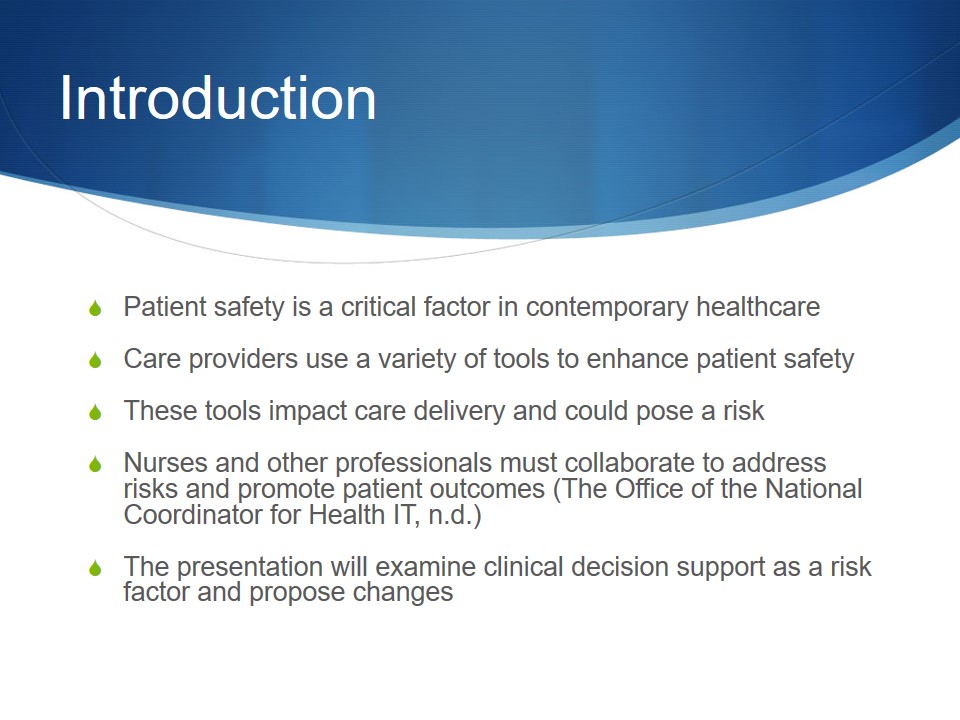
Information Technology as a Risk Factor
- Information technology is an essential component of care delivery in the U.S.
- It is used to schedule appointments, process patient data, and collect information on patients.
- CDS is a recent tool that improves guideline adherence and diagnostic decision-making (Alotaibi & Federico, 2017; Lopez et al., 2017).
- CDS is used to offer customized advice to care providers based on patient data (e.g., screenings, medications, and risk factors).
- Incorrect implementation or use of CDS poses a risk to patient safety.
- Research points to a variety of CDS benefits and problems and suggests potential solutions.
Information technology has a significant role in today’s healthcare environment, since it can be used to schedule appointments, process patient data, and collect information on patients. CDS is a recent health IT tool that offers customized advice to care providers based on patient data, such as past screenings, medications, and risk factors. CDS proved to be effective in reducing medication errors and improving guideline adherence. However, the technology could also pose a risk to patient safety in case of incorrect implementation or internal problems. Research studies on the use of CDS point to a variety of problems and suggest potential solutions.

Issues with CDS Alerts
- Alerts that are part of CDS systems can be inappropriate or misleading (McCoy, Thomas, Krousel-Wood, & Sittig, 2014).
- This issue is mainly due to problems with data or poor integration with patient information systems (Tcheng et al., 2017).
- Inappropriate alerts impair physicians’ trust in CDS, leading them to ignore future notifications.
- Reports show that over 30% of alerts are ignored (Alotaibi & Federico, 2017).
- Misleading or inappropriate notifications pose a risk to patient safety and increase the likelihood of errors.
The primary issue of CDS systems is inappropriate or misleading alerts, which can occur due to the low quality of data or poor integration with patient information systems. Inappropriate notifications can impair trust in CDS systems, reducing compliance. They also pose a threat to patient safety by increasing the likelihood of medical errors.
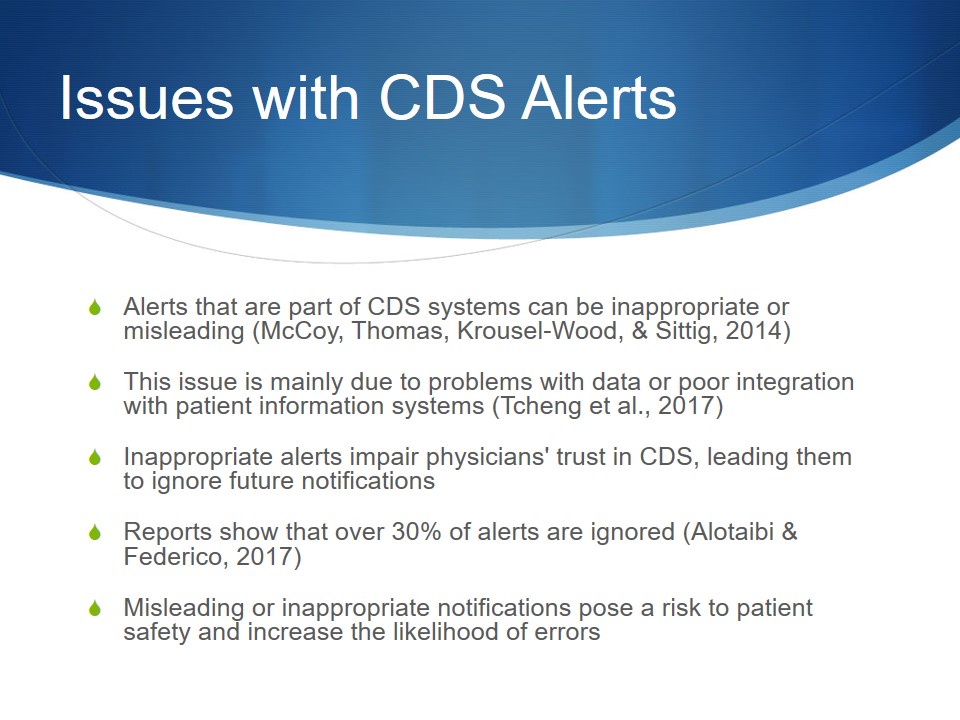
Other Problems
- CDS systems can disrupt care providers’ workflow (Alagiakrishnan et al., 2016).
- The need to learn how to use a CDS system adds to the overall workload (Alagiakrishnan et al., 2016).
- These issues can cause the provider to pay less attention to patients.
- By causing clinicians to miss essential details, CDS impairs patient safety and leads to errors.
- Clinician liability and accountability are also important issues related to CDS (Alagiakrishnan et al., 2016).
- This might cause care providers to follow alerts that propose risky tests or unproven treatment options.
Other issues related to CDS use are workflow disruption and the growth of workload. These factors can distract care providers from their patients, thus causing them to miss important details and make errors. Also, clinician liability and accountability are not well-defined in most institutions using CDS. This is also a risk since clinicians could decide to still comply with alerts that they consider misleading.
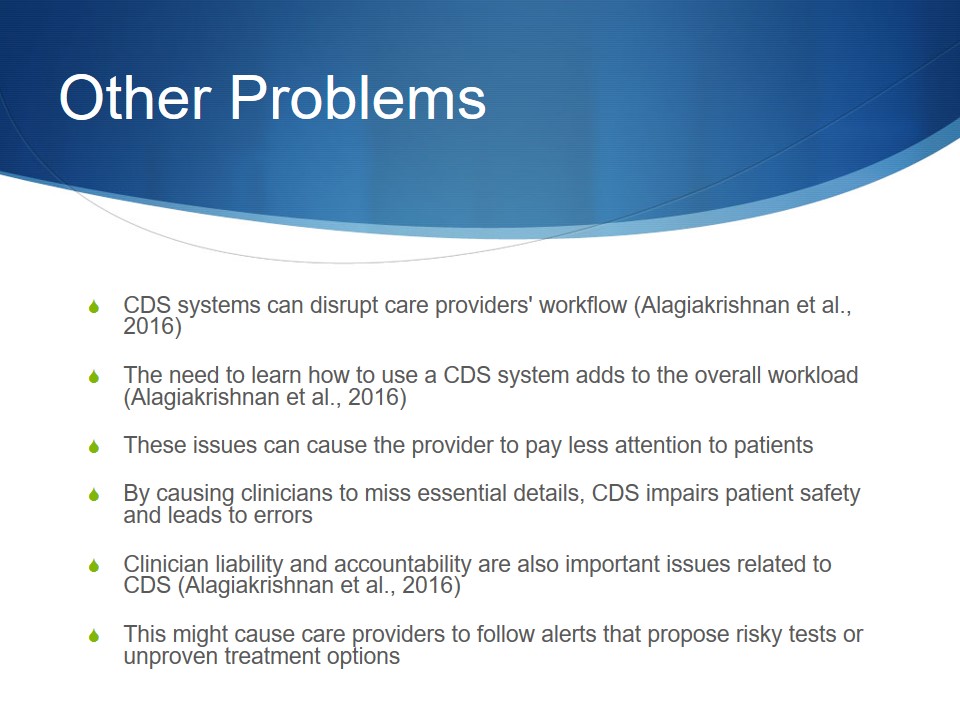
Possible Solutions
- CDS systems should be fully integrated into other health IT tools (Alotaibi & Federico, 2017).
- Updating CDS databases regularly is essential to improve alert quality (Alotaibi & Federico, 2017).
- Testing CDS systems before implementation is advised (Alagiakrishnan et al., 2016).
- Some reports show better success rates for alerts that need a reason to be overridden (Alotaibi & Federico, 2017).
- Information in CDS must be filtered and incorporated into the traditional workflow (Tcheng et al., 2017).
Research also identifies some possible solutions to these issues, including the improved integration of CDS into other health IT tools, regular updating of CDS databases, and testing systems before their implementation. Additionally, requiring a justification to override the alert could help to improve compliance. It is also advised that information in CDS is carefully filtered and the system is incorporated into the traditional workflow to avoid disruptions.
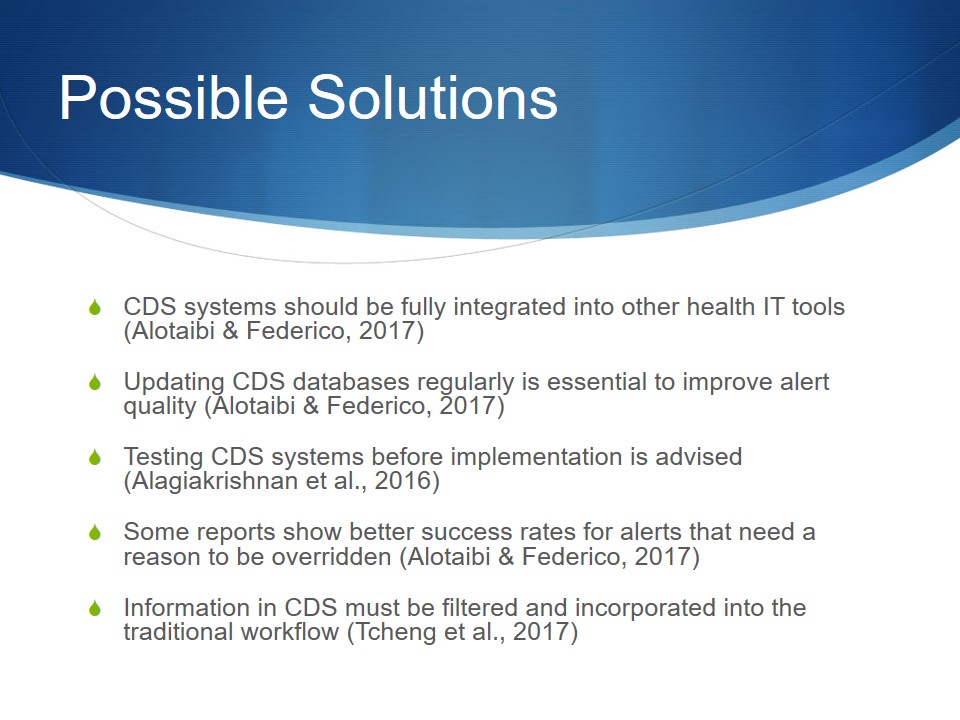
Proposed Redesign
- Clinical staff should receive training and participate in testing of a new CDS system, including built-in user advice.
- CDS systems should be adequately connected to EHR records to prevent inappropriate alerts.
- Clinicians should be able to review CDS notifications in preparation for the appointment.
- This would allow them to focus on the patient during an appointment.
- Performance and acceptance of CDS should be monitored to amend components of the system as required to suit clinicians’ needs.
The proposed redesign includes four key features: training, testing, integration, and monitoring. First of all, all clinicians should be given proper training and allowed to test the CDS system before implementation. Secondly, the information in CDS should fully reflect the EHR data of patients to offer customized advice. Thirdly, it would be useful to show alerts and reminders prior to appointments to allow providers to focus on patients. Lastly, CDS systems should include monitoring and review features to control performance and enable clinicians to share issues or concerns.
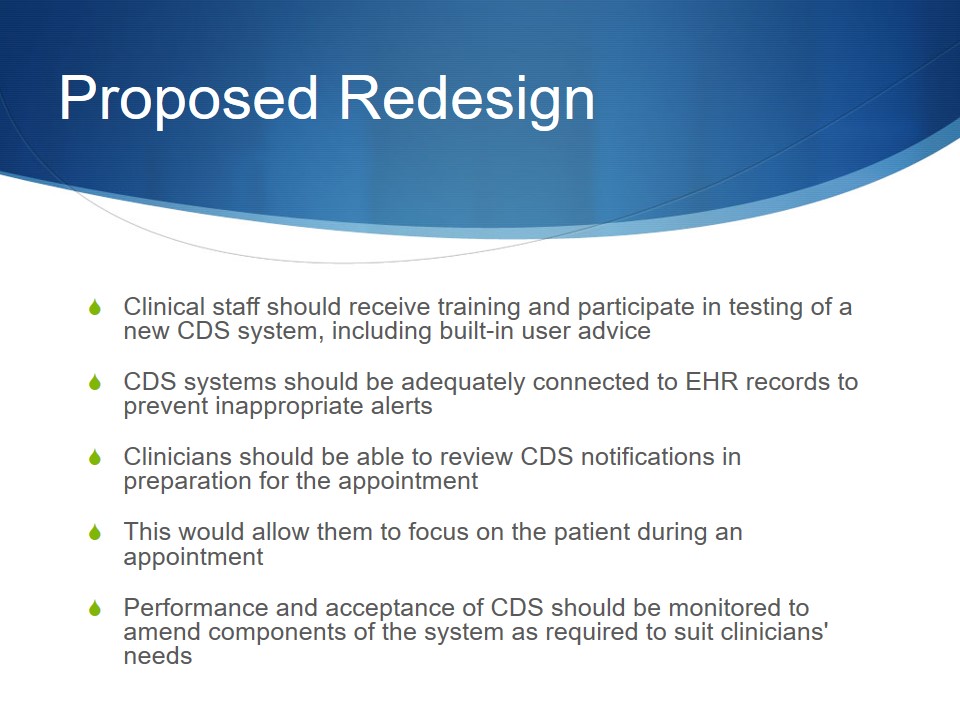
The Role of Nurse Leaders
- Nurses are among the key CDS users in most settings.
- At the design stage, nurse leaders can provide insights into preferred functions and features of CDS.
- Nurse leaders can also help to identify issues in CDS implementation.
- Leaders who have experience in CDS can provide training or assistance to other personnel.
- Nurse leaders should also ensure safe IT use by nurses, both at work and at home (Brous & Olsen, 2017).
In clinical settings, nurses use CDS along with many other health IT tools. Thus, nurse leaders can provide valuable insight and suggestions at the design stage, as well as identify issues during the implementation. Nurses who are experienced in using CDS can also assist or train their colleagues to improve the acceptance and use of the system. To support the meaningful use of technology, nurse leaders should ensure nurses’ compliance with the principles of safe IT use, both at work and at home.

Conclusion
- Health IT can have benefits and drawbacks, depending on many factors.
- CDS systems can contribute to patient safety by increasing guideline adherence and preventing errors.
- Successful implementation of CDS requires a comprehensive effort.
- Redesigning CDS systems based on recommendations will improve patient safety and outcomes.
- Nurses and other care providers should play an important role in the implementation process.
Overall, health IT has both benefits and drawbacks, and the likelihood of success depends on various factors. CDS systems can improve patient safety by increasing guideline adherence and preventing errors, but only if they are implemented successfully. In order to do that, CDS providers should collaborate with end users to redesign the system based on recommendations. This process will assist in enhancing patient safety and health outcomes.
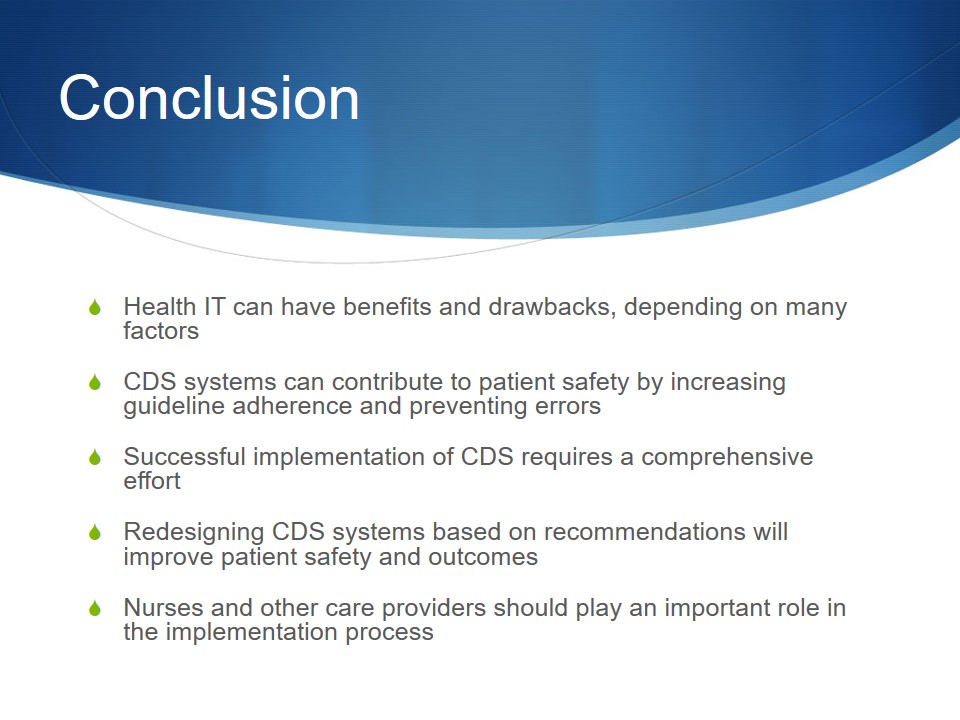
References
Alagiakrishnan, K., Wilson, P., Sadowski, C. A., Rolfson, D., Ballermann, M., Ausford, A., … Hayward, R. S. (2016). Physicians’ use of computerized clinical decision supports to improve medication management in the elderly – The Seniors Medication Alert and Review Technology intervention. Clinical Interventions in Aging, 11(1), 73-81.
Alotaibi, Y. K., & Federico, F. (2017). The impact of health information technology on patient safety. Saudi Medical Journal, 38(12), 1173-1180.
Brous, E., & Olsen, D. P. (2017). Lessons learned from litigation: Legal and ethical consequences of social media. AJN The American Journal of Nursing, 117(9), 50-54.
Lopez, K. D., Gephart, S. M., Raszewski, R., Sousa, V., Shehorn, L. E., & Abraham, J. (2017). Integrative review of clinical decision support for registered nurses in acute care settings. Journal of the American Medical Informatics Association, 24(2), 441-450.
McCoy, A. B., Thomas, E. J., Krousel-Wood, M., & Sittig, D. F. (2014). Clinical decision support alert appropriateness: A review and proposal for improvement. The Ochsner Journal, 14(2), 195-202.
The Office of the National Coordinator for Health IT. (n.d.). Chapter 4: Understanding electronic health records, the HIPAA security rule, and cybersecurity. Web.
Tcheng, J. E., Bakken, S., Bates, D. W., Bonner, H. III, Gandhi, T. K., Josephs, M., … Lopez, M. H. (2017). Optimizing strategies for clinical decision support: Summary of a meeting series. Web.